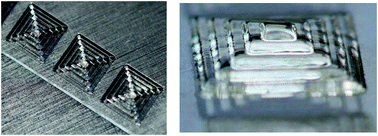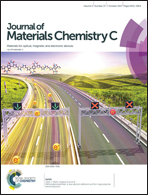3D reactive inkjet printing of polydimethylsiloxane†
Abstract
Material jetting is a process whereby liquid material can be deposited onto a substrate to solidify. Through a process of progressive additional layers, this deposition can then be used to produce 3D structures. However, the current material jetting catalogue is limited owing to the constraints on the viscosity of inks that can be deposited. Most inks currently being used are either solvent or photocuring based, with the latter becoming increasingly popular due to increased throughput. Full Reactive Inkjet Printing (FRIJP) is an alternative processing method currently being investigated as a route to widen the material catalogue. FRIJP is the combination, on the substrate, of two reactive components which then react together in contact on the substrate. In this work a two-part polydimethylsiloxane (PDMS) ink has been developed, printed individually, and cured. The successful printing of PDMS has been used to fabricate complex 3D geometry for the first time using FRIJP. Through the use of a prepared substrate feature resolutions up to 48 ± 2 μm (X, Y) were possible. Curing analysis has been conducted. It was found that not only does the reaction occur to a similar degree to conventional processes, but that there is no variation in the cured sample when printed at elevated substrate temperatures.



 Please wait while we load your content...
Please wait while we load your content...